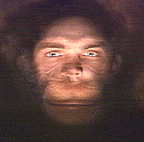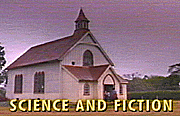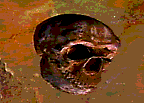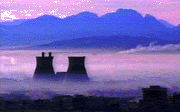
Volume 1 Number 14
September 15, 1995


|
Apeman
Episode Four: ``Science and Fiction."
Arts & Entertainment Network. 52 minutes.
Distributed as part of the Cable in the Classroom project: 7
- 8 a.m. Eastern time, Friday, September 22.
Grades 7 - 13 / Ages 11 - Adult.
Review by Duncan Thornton.
|
exerpt:
For many years the thought that's been most difficult for
everyone to come to terms with, and agree about, is that evolution hasn't
been working toward creating us: we just happened.
 This is the final part of Cable in the Classroom's presentation of the
A&E series on the development of the human species, APEMAN.
(Part Three, ``It's All in the Mind," was reviewed here last week.)
This is the final part of Cable in the Classroom's presentation of the
A&E series on the development of the human species, APEMAN.
(Part Three, ``It's All in the Mind," was reviewed here last week.)
Host Walter Cronkite wraps up the series with a program that
considers the history of archaeological thought itself, and how cultural
attitudes have moulded our understanding of the fossil record. (I should
mention here that though the series treats creation accounts with great
respect, it is straightforward about presenting evolution as a scientific
fact in roughly the same category of certainty as the orbit of the Earth
around the sun.)
This is really an intellectual history then, and so lacks a little
of the appeal of previous episodes, but it remains smooth
and fascinating. It lays out with excellent examples (early silent films
about Neanderthals, for example) how our interpretation of the fossil
record has changed with the times.

Thus Neanderthal remains were misinterpreted as being more ape-like
and stooped than they actually were because the notion that these
relatively recent and brutish creatures could be our ancestors was
unappealing. Surely our real ancestors must have been smarter and
more human far earlier? Thus the world was ready to be taken in by the
famous Piltdown Man hoax, where a modern human cranium and an orangutan
jaw were fit together to ``prove" we were smart -- if not lovely -- millions of years earlier.
Similarly, the ``Killer Ape" view of early hominids seemed quite
plausible, somehow even an explanation, after the savagery of the Second
World War. But it now seems clear that early hominids were really the hunted
-- prey of sabre-tooth tigers and other large carnivores -- more than the
hunters.

Finally, after probing the ways our prejudices have skewed
understanding of the fossil record, the last few minutes of ``Science and
Fiction" moves to an area even more speculative than pre-history, as
anthropologists discuss the plight of this hunter-gatherer species living
in a technological world we have not fully adapted to, and speculate on
the future of humanity, or its descendants.
It's interesting, but sketchy, and a little disappointing after the
promise to examine the subject at the end of Part Three. A better
treatment of the problems our technological evolution has led us into
could be found in Gwynne Dyer's NFB series The Human Race,
(part one of which, ``The Bomb under the World" was reviewed in volume I,
number 3 of CM). Actually, showing the Dyer series
after APEMAN would almost constitute a good eduction by itself.
But in all, a good finish, showing the intellectual problems behind the story the series has told. Worth
setting the VCR for.
Recommended.
Duncan Thornton is the Editor of Canadian Materials.

Copyright © 1995 the Manitoba Library Association.
Reproduction for personal use is permitted only if this copyright notice is
maintained. Any other reproduction is prohibited without permission.
Published by
The Manitoba Library Association
ISSN 1201-9364
 Go back to CM Welcome page
Go back to CM Welcome page
 Go back to Table of
Contents for this Issue
Go back to Table of
Contents for this Issue



 This is the final part of Cable in the Classroom's presentation of the
A&E series on the development of the human species, APEMAN.
(
This is the final part of Cable in the Classroom's presentation of the
A&E series on the development of the human species, APEMAN.
(
